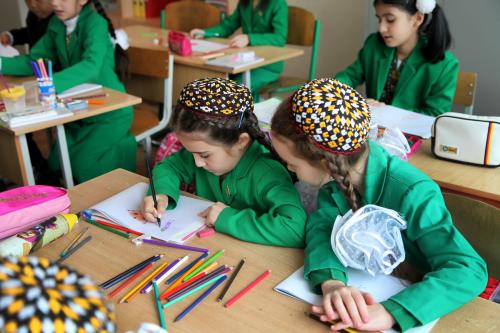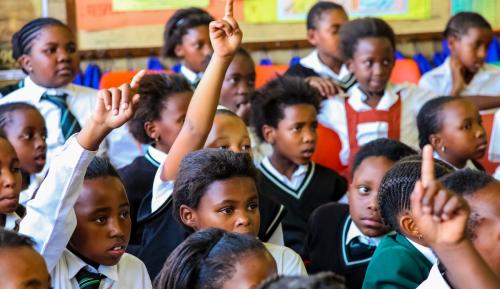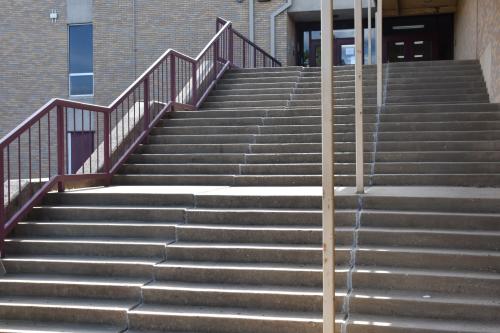After the ISIS attack in Paris in November—the deadliest terrorist episode in the European Union in over a decade—nations fell divided, with some holding firm on their commitment to welcome Syrians, while others reproached refugees for fear of terrorist infiltration.
Amid this disappointing debate, it is clear that Syrian children are the lasting victims of a war that has shattered their families, homes, and schools. Responding to the refugee crisis has never been more important, and now in Turkey—the country that hosts the largest number of Syrians—there is an opportunity to reach over 400,000 Syrian children who are out of school.
This opportunity developed as the Turkish government responded to three different phases of the Syrian education refugee crisis.
Three phases of the education refugee crisis
In the first phase of the refugee crisis starting in 2011, many analysts predicted the Syrian war would be short-lived. Turkey’s government welcomed Syrians as guests and housed them in camps said to be the best in the world. By the end of 2013, there were 20 camps on the southern border, and in those camps most children were attending school. The Turkish government led the response with support from the United Nations.
In 2014, in a second stage of the refugee crisis, Turkish camps hit capacity after admitting over 200,000 Syrians. With borders closing to Syrians in neighboring countries, the number of Syrians flooding into Turkey ratcheted up. A string of protests against Syrians flared in the south.
Syrian-run schools funded with private money, often from the Gulf, became the main source of refugee education. The Turkish government cleared the way for the U.N. to build schools outside of camps in southern provinces, by passing legislation for the temporary protection of Syrians, providing the right to education.
The refugee crisis entered a third, critical phase in October of 2014, when ISIS sieged hundreds of villages around Kobane. An additional 400,000 Syrians from Kurdish areas crossed Turkey’s southern border.
As the number of refugees in Turkey approached 2 million, Turkey registered a number of international education nonprofits and developed an institutional framework for Syrian children based on the right to education in formal schools and Arabic-language “temporary education centers.”
Three spheres to support Syrian education
Today, Turkey is providing education to 200,000 children and has committed to double this number by the end of the school year. To support Turkey’s efforts there are three spheres where international actors can engage.
First, almost 40,000 Syrian children are studying in Turkish public schools. Language is the most formidable barrier to enrollment, especially for older children who struggle to learn by immersion. Language support programs are limited, and teachers don’t receive training for multilingual classrooms.
Hidden education fees and a lack of transportation keep other children out. Many families don’t know their right to enroll, or report being turned away by school headmasters who are not aware of new regulations. The strain on the school system is also an issue: Syrian families often settle in low-income neighborhoods where education systems are already in need of support.
With no end to the war in Syria in sight, many Syrian children are in Turkey to stay and they need to adapt to the language and culture to be successful. Working with the Turkish government and complementary organizations to address the challenges to Syrian student’s enrollment and learning in formal education, with an eye to the quality of education, is possibly the most important long-term investment that international partners can make.
Second, the Turkish government expanded educational options for Syrians through temporary education centers (TECs), often operated in the afternoon from 1:30-5:00pm in public school buildings. Classes are in Arabic, taught by Syrians, based on a modified Syrian curriculum. The ministry and the Syrian Interim Government jointly offer school-leaving exams.
TECs provide an educational option for families that want their children to learn in Arabic among their Syrian peers, an important choice for children who have been through immeasurable strain and loss. TECs are significantly less expensive to operate than formal education.
There are not yet enough TECs in the country to meet demand for enrollment, especially at the high school level. Syrian teachers receive small stipends, as they cannot be employed in Turkey. Areas for TEC partnership include building classrooms, teacher training and support, and the provision of materials and technology that support learning.
The Turkish government has spent over $6 billion on Syria refugees, and now seeks direct financial support for their national program. Individual provinces, especially those with large numbers of Syrians, can develop direct partnerships.
The third sphere for engaging in Turkey is outside the traditional classroom, where Syrians and Turks, driven by their shared history and culture, are starting and building small organizations to address the issues they see on the front lines of the education crisis.
These efforts boost demand for education among Syrians by strengthening families. Some offer alternatives, for instance to the Sunni Islamic lessons in formal schools. Other groups combat child labor by seeking labor permits and decent work for parents.
I visited with one such group on the Syrian border in Kilis, an ancient city where Syrians now outnumber Turks. There, the mayor led me to the Keramat Center, founded by Najlaa Sheekh of northern Syria. Together with 18 mothers, she started one of the only centers for Syrian women in southern Turkey.
After walking through the knitting workshop, Najbaa took me to the heart of Keramat: the preschool below. There, I found children singing the English alphabet. They are also learning Turkish, and so are their mothers. These small children are getting unusual support at the pre-primary level: Many have siblings just a few years older who are already working to support their families.
In the Kilis Square this Ramadan, Najbaa and the other Syrian women sat around a long rug near the mayor’s family, breaking fast. Najbaa told me that, “Keramat” means generosity, named for the many Turks and Syrians working together for Syrian children.
Turkey has spent more on Syrian refugees than any other country worldwide. With legislation, planning, and partners on the ground, the main ingredient lacking now is global action.
This blog was adapted from a speech given by the author at a State Department event in Washington DC, titled “Bridging the education gap for refugee children in Turkey.”
The Brookings Institution is committed to quality, independence, and impact.
We are supported by a diverse array of funders. In line with our values and policies, each Brookings publication represents the sole views of its author(s).



Commentary
The refugee crisis in Europe: Bridging the education gap for Syrians in Turkey
November 30, 2015